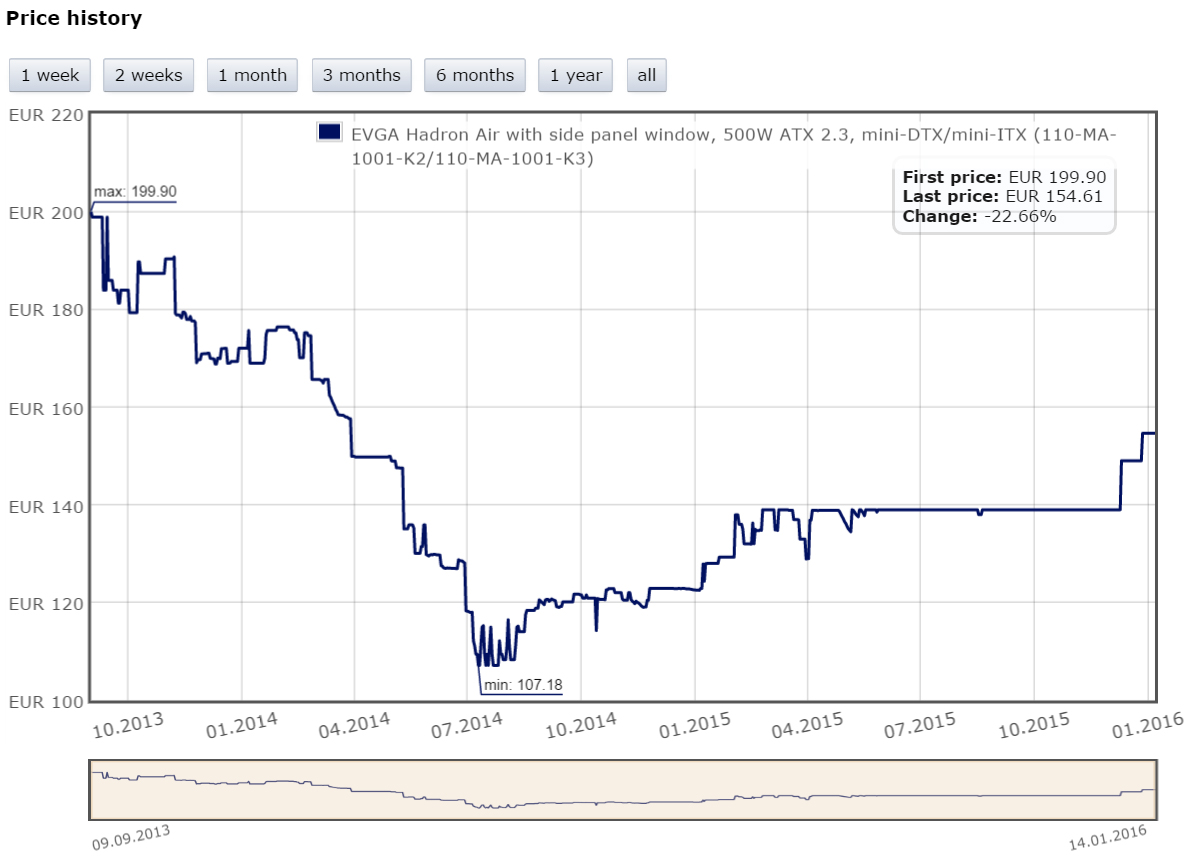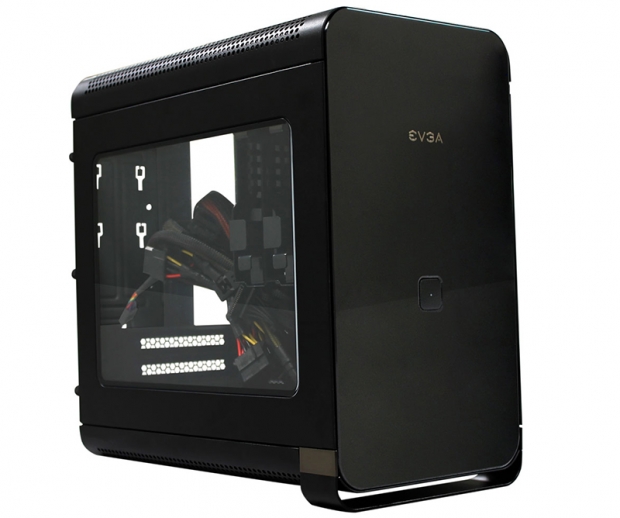Index
Review: Small form factor can host a lot of power
Hadron Air has been an alternative solution for gamers that like small form facor PC and are happy with Mini ITX board and still want to plug a decent GPU in this tiny gaming system. Our Hadron Air has been a good friend for more than two years and for buiding a mini-ITX system it is still one of the best choices.
Since the release of Hadron Air and its siblingthe Hadron Hydro, EVGA has been quiet in the PC-case hardware sector. Then at this year’s CES they showed the new gamer oriented full-sized PC case.
This newcomer is still in development but we love it already. It draws on the idea of exposing the interior, which is traditionally done by using a transparent windows, and placing all the standard buttons and connectors on the window side, including the power button, USB ports and one digital fan speed indicator. This way you can put the chassis sideways next to you and have everything in your line of sight. The new chassis is not designed for hiding at floor level.
Side panels can be removed simply by pressing push buttons. Inside the case you can put water cooling and 4-way SLI too. The grid with huge fins provides a great airflow through and out of the system. The image below shows that design is already polished and we expect it this year on shelves.
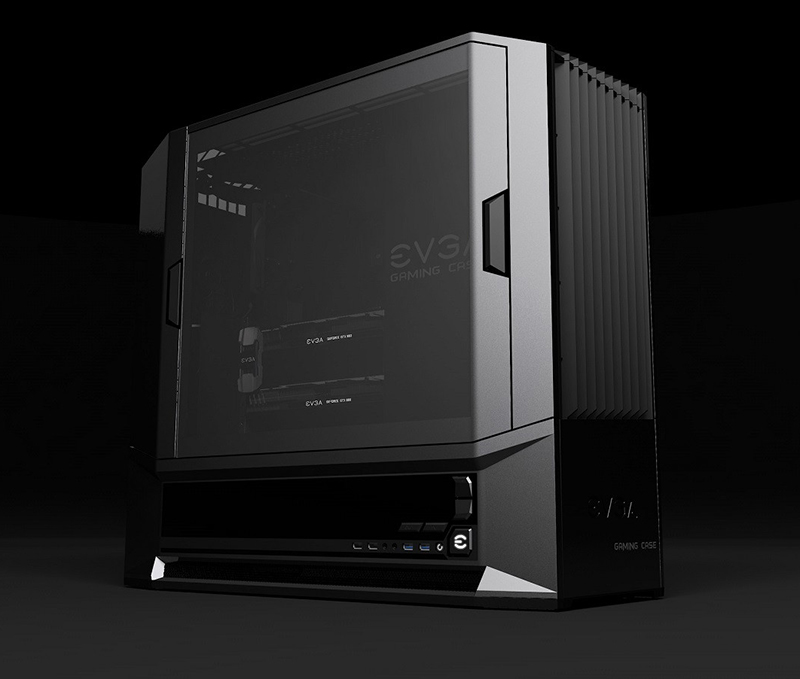
The Hadron Air which we review today is different from the chassis shown above, especially the size. At a mere 305mm height, 169mm width and 308mm length, the Hadron Air chassis is extremely small; we could put it with ease inside the new EVGA full-tower chassis. Hadron Air supports only mini-ITX motherboards, but unless you are in a need for a multi graphics-cards configuration or a motherboard with several expansion slots, mini-ITX motherboards could be a good base for building a powerful gaming PC.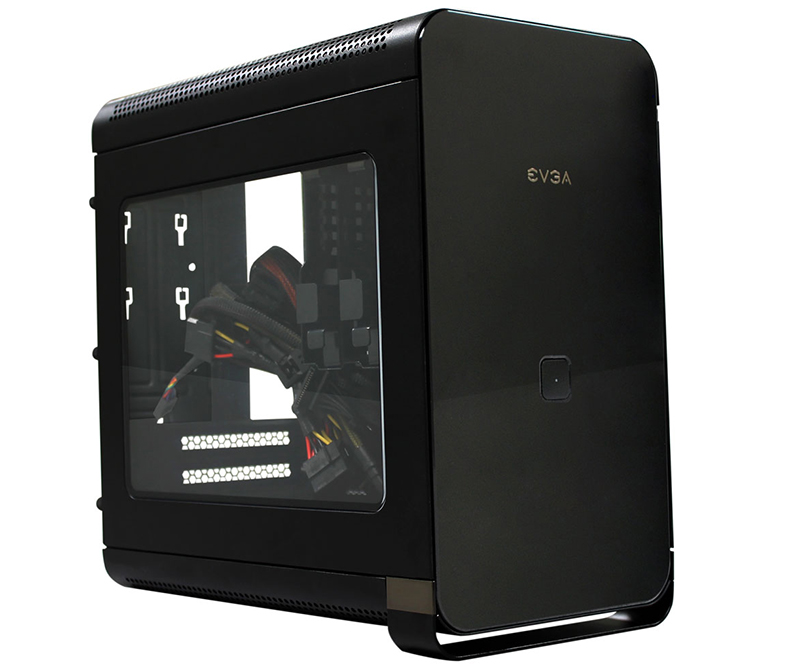
Specifications:
- Case Type: SFF Chassis
- Material: Plastic & Steel
- Weight: 6 kg
- Expansion Slots: 2
- Drive Bays:
1x Slimline Slot-In
2x Internal 2.5/3.5"
- Motherboard: Mini ITX (17x17cm in size)
- Dimensions: 305mm height, 169mm width and 308mm length
- Front Door/Cover: N/A
- Front Fans /Rear Fans /Bottom Fans /Side Fans: N/A
- Top Fans: 2x 120 mm (included)
- I/O: 2x USB 3.0
- 1x Headphone
- 1x Microphone
- Included PSU: 500W 80Plus Gold, Single 40A Rail, Slim-design
- Graphics card length: 267mm
- CPU cooler height: up to 135mm
The Packaging
EVGA Hadron Air comes with pre-installed 500W PSU. You will also find a power cable in the box. The box of extras contains also two shorter SATA data leads, all the basic screws, and two plastic pieces to aid in cable management. Further there is a tray for the slimline ODD, a manual, and some stickers.
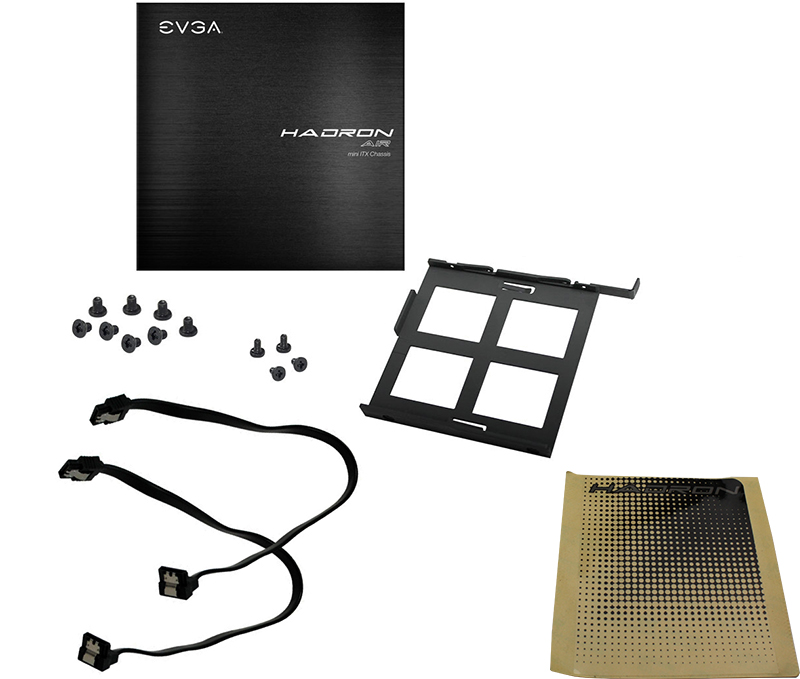
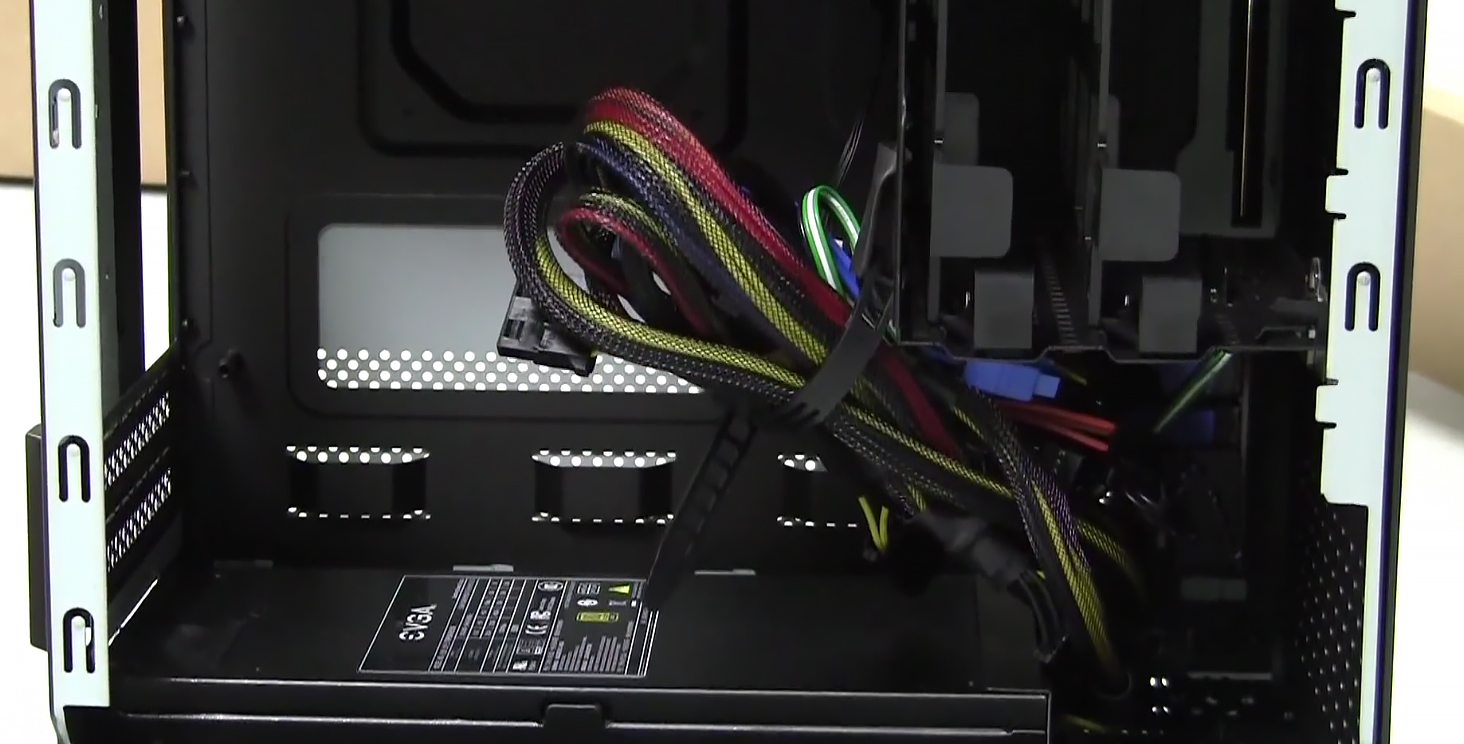
A closer look - outside
The Hadron Air is compact PC-case with a simple but clever design. There is no drive bay at the front, just a square power button in the middle accompanied with the decent EVGA logo. Luckily the drive bay is present but as a slot-loading slimline drive bay, and it is moved to the side panel of the chassis. Slimline drives are not cheap, especially Blu-ray drives, but at least EVGA provides an option and many other chassis don't. However the user should be careful when purchasing the slimline drive and do check whether the provided eject button line up with the desired drive.
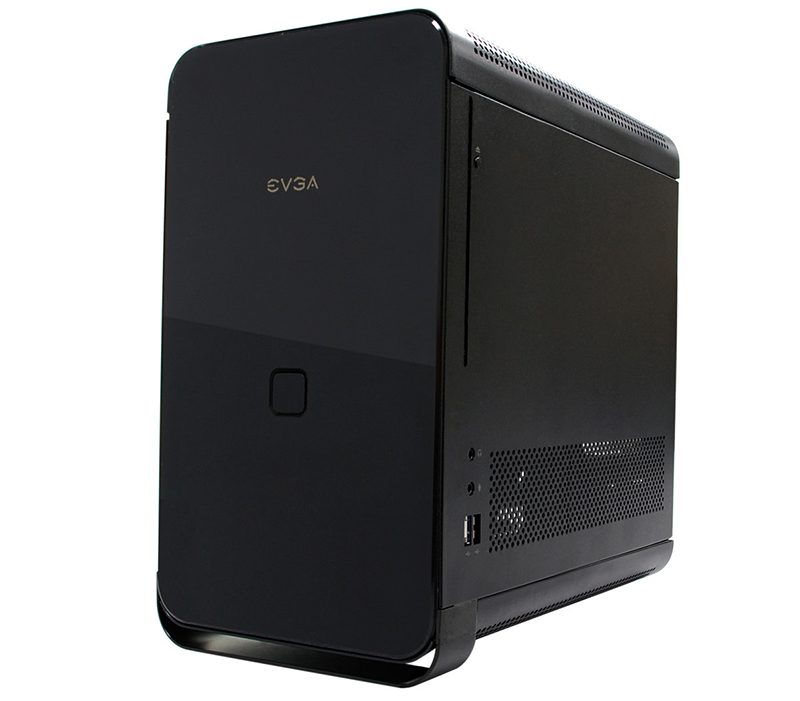
On the right side we have two USB 3.0 ports and the usual pair of 3.5mm Audio plugs. All sides except the front panel are made of steel with a nice matte finish.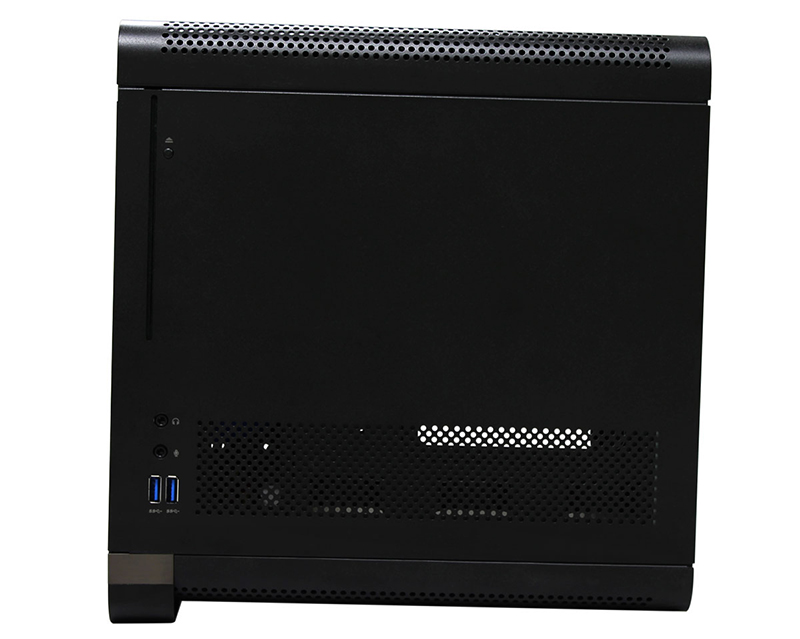
The air vent along the bottom part of the right panel is meant to let the fresh air inside the case. Two 120mm fans are placed on the top panel to push hot air out of the chassis, and there is no room for additional fans in the Hadron Air. Therefore the whole top panel is designed as a huge air vent.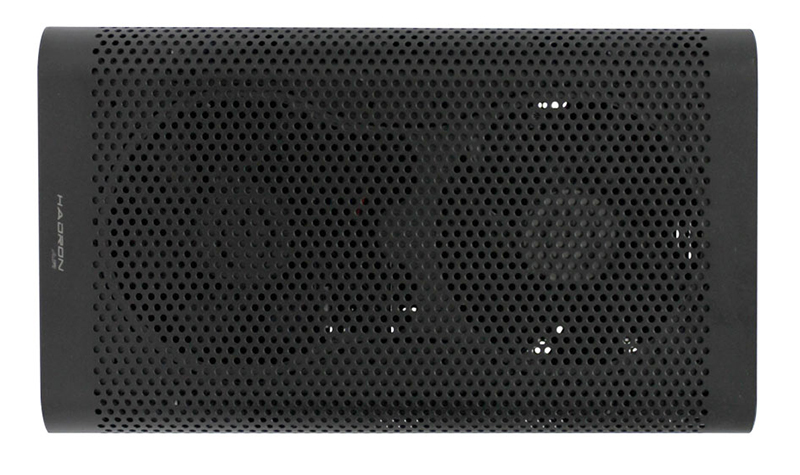
The top panel and the both side panels can be removed with a help of a screwdriver. Mostly you will have to remove only the panel with the window, which you can slide out easily after removing two thumbscrews.
Nothing can be hidden inside the Hadron Air chassis since the whole panel is a window , so you will probably spent some time before all cables are routed nicely.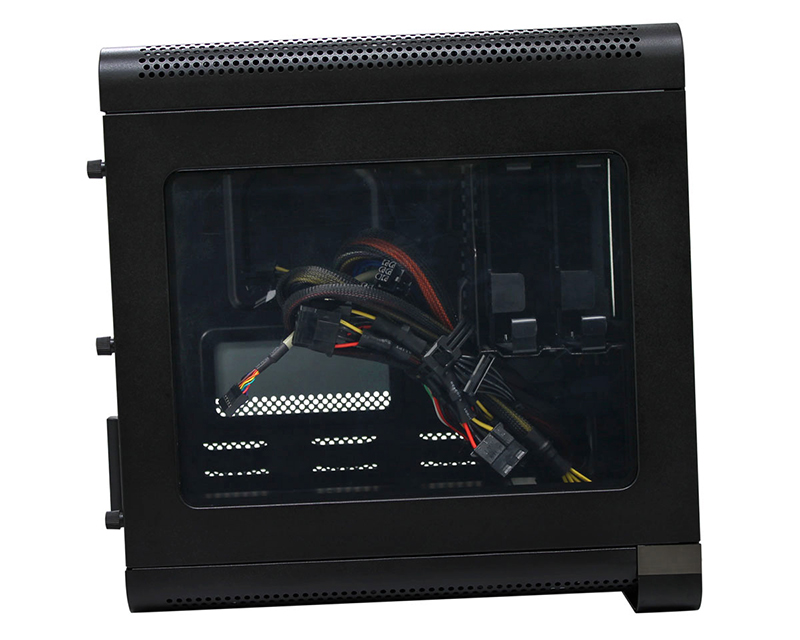
On the rear side you can see two motherboard expansion slots. Inside the Hadron Air you can house most of the high end graphics cards, which are dual slot and have length up to 267mm. The Hadron Air comes with a 500W 80 Plus Gold certified 1U power supply, and the small PSU fan is visible on the bottom right of the back panel. The fan is quiet.
The two openings for an external liquid-cooling setup are also provided, however for using water cooling we suggest you to take look at the Hadron Hydro which is another mini-ITX case from EVGA.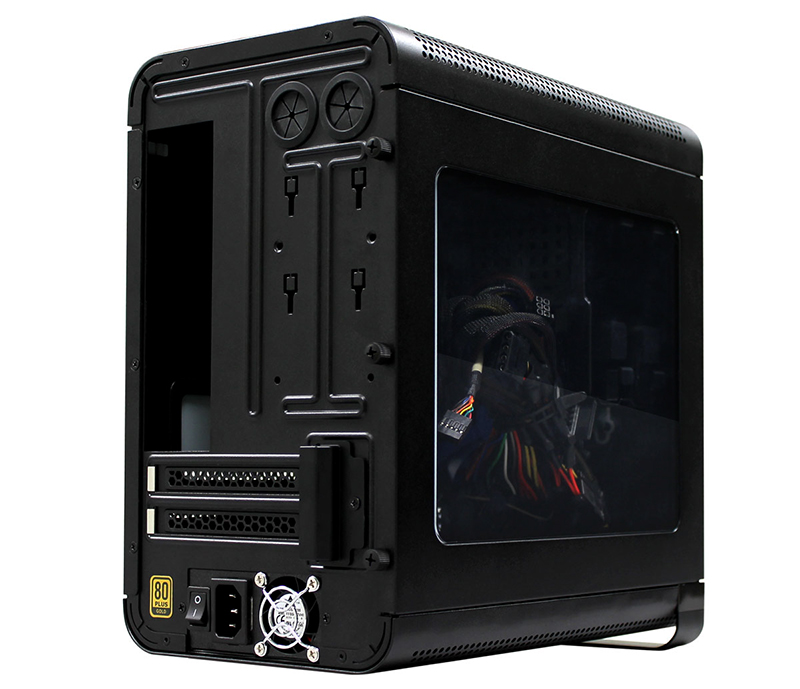
Notice how the Hadron Air is not laid flat on the table, it is tilted due to the higher front stand.
A closer look inside & Assembly
After the side panel with the window is removed you can easily access to the whole interior. However, the Hadron Air is very compact chassis and once all hardware components are installed there will no be space for big maneuvers inside. Wiring things may end up also a bit tricky but considering the space available cable management is decent. We don’t like the blue USB 3.0 cable, however.
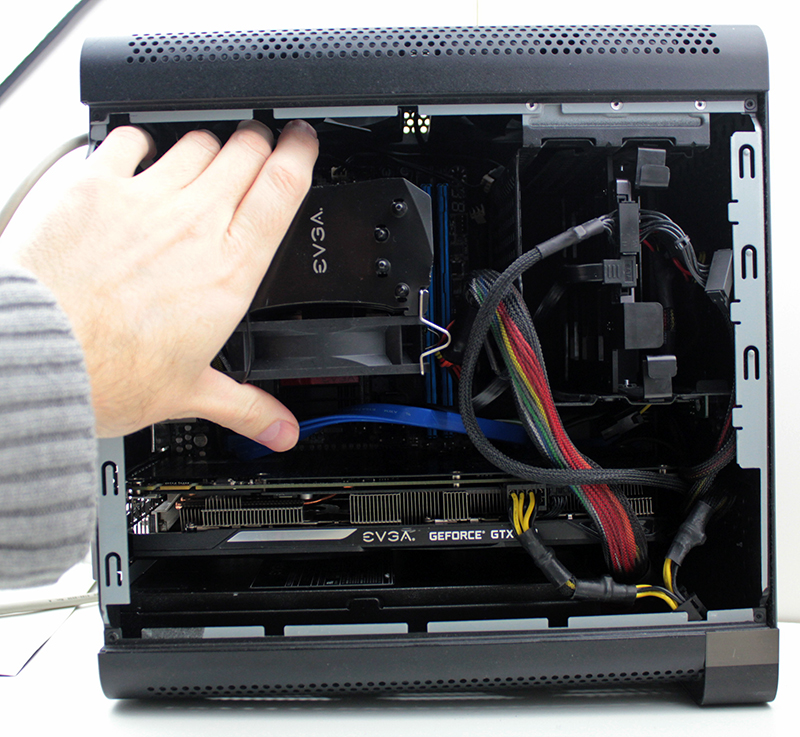
Under the CPU area there are no cutouts in the motherboard tray. Depending on the cooler type in your hands, this may create an issue, by forcing you to install the motherboard with the CPU cooler already attached. CPU coolers with a push-in pins are more convenient for using in the Hadron Air. But we do not expect from a mini-ITX chassis to provide a lot of space, we want it to be as compact as possible, right.
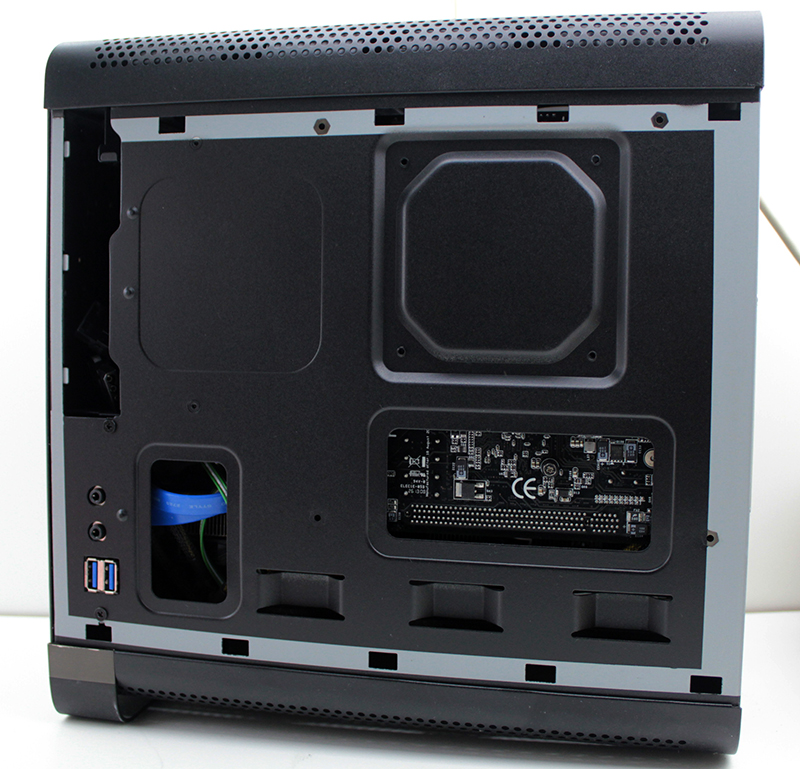
The back panel is held in place using two standard screws so you will need a screwdriver. It’s a shame that EVGA did not used thumbscrews everywhere, especially considering high price for the Hadron Air. Holes in the motherboard tray are mainly for air circulation, there is not enough space behind the tray to route cables.
The drive cage for storage units is the only separated space inside the Hadron Air. It provides space for two 2.5” or 3.5” storage units. Also this is a home for the slim optical-drive bay.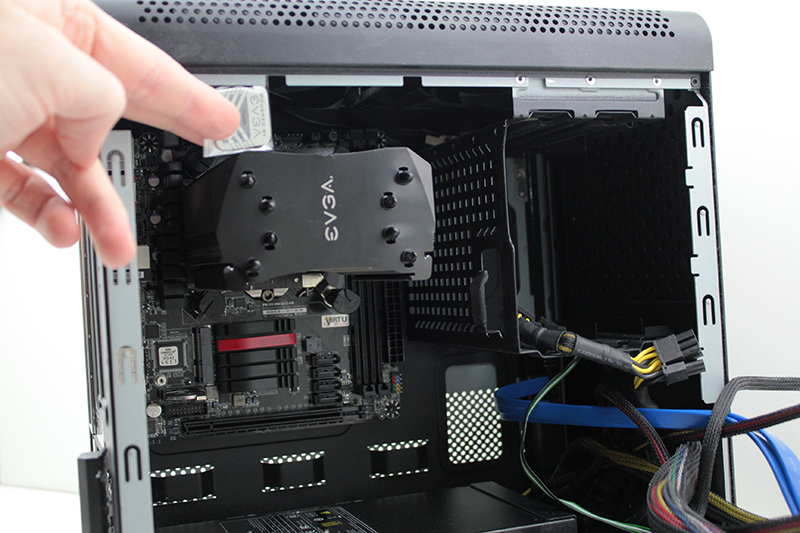
Hard drive cage comes with two removable trays which are stable once a 3.5” drive is inside. Such drives do not require any tools for installation. Smaller 2.5” drives must be secured with supplied screws inside the tray.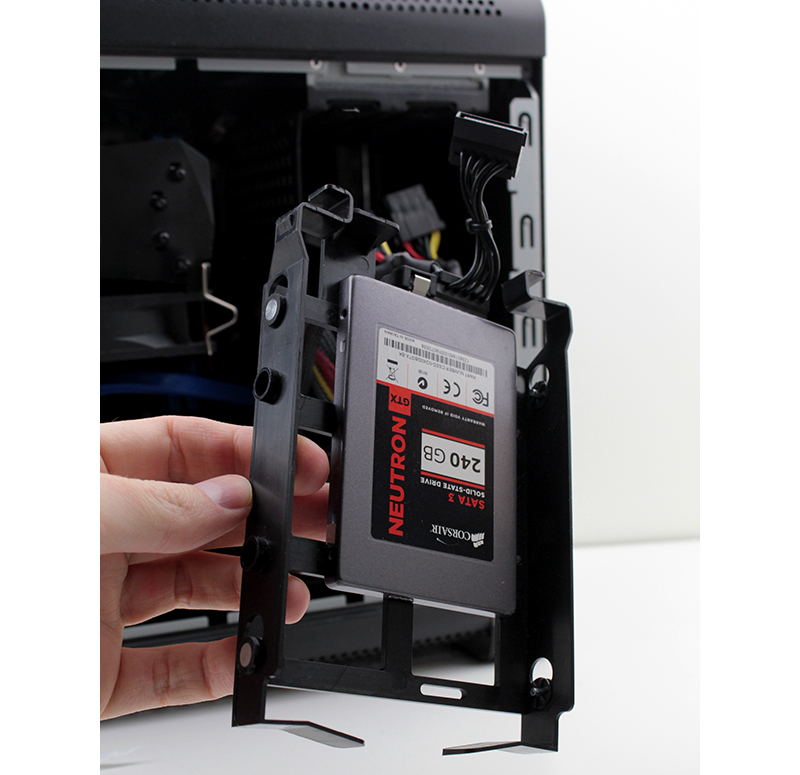
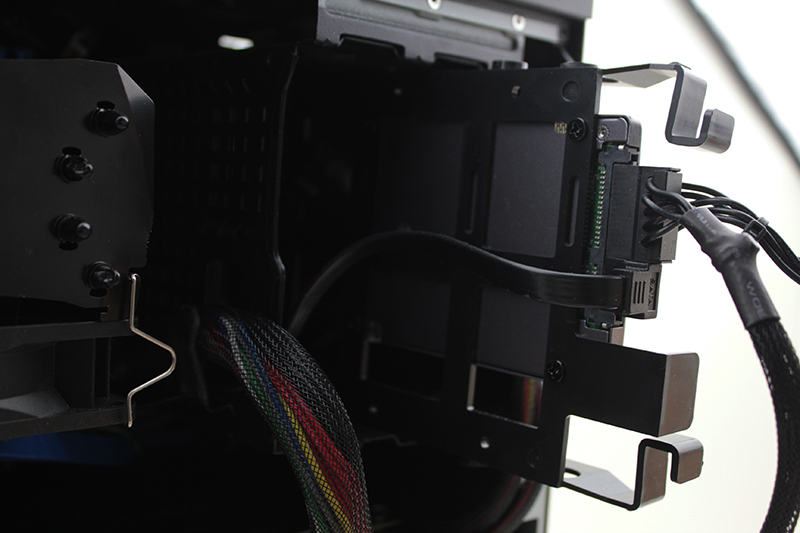
The trays are secured with the hinge, thus you can easily insert or remove the trays.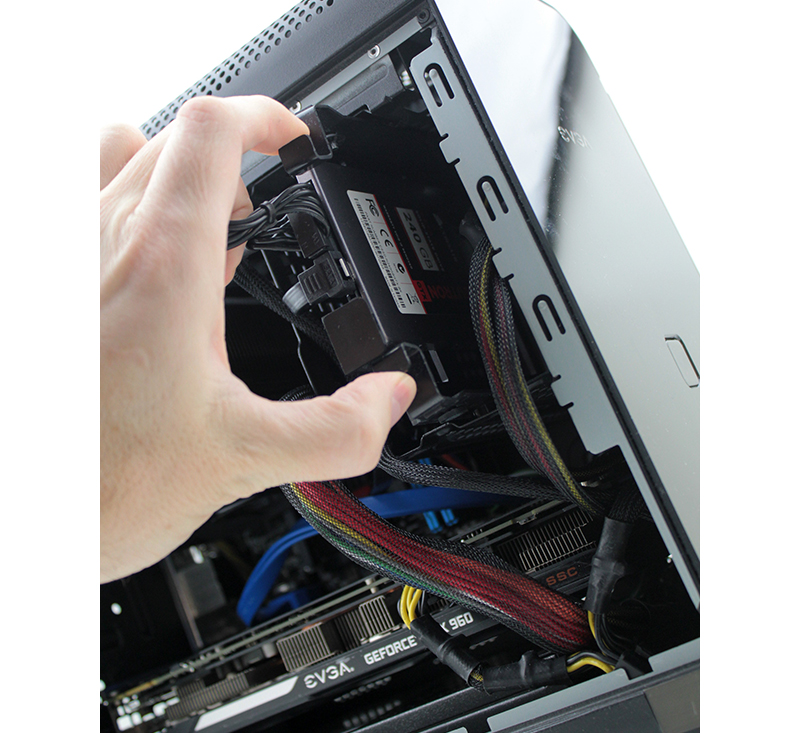
As noted earlier, two 120mm exhaust fans are installed under the top panel.

There is not enough space for replacing the two fans with a 240mm radiator. The radiator can be mounted on the top panel, but only from the outside.
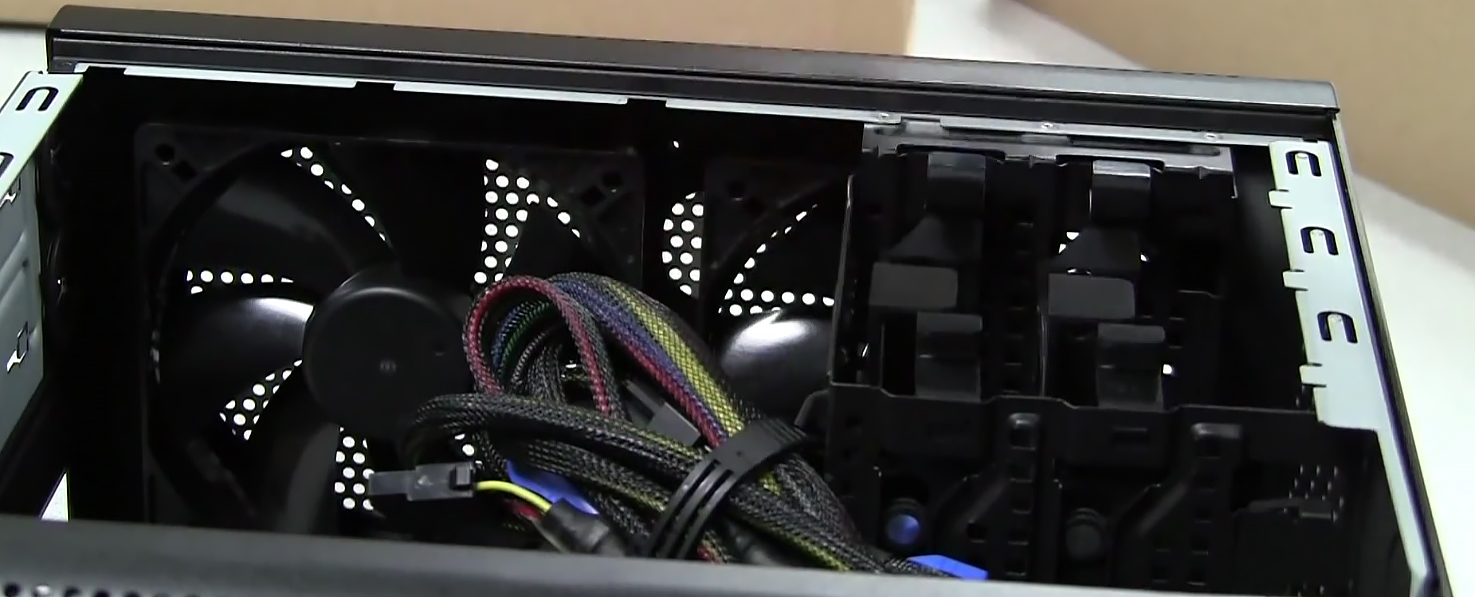
Both 120mm fans are powered via 3-pin connectors but those are adjoined. This is great since most mini-ITX motherboards are sparse about providing fan connectors. Installed fans do a good job in keeping things cool inside the compact Hadron Air chassis.
Assembly continued
The bottom panel holds the integrated 500W Gold rated power supply (w/ 40A on +12V rail). This unit takes the entire floor and only place where you can hold unused cables in below the HDD cage. The PSU is very important component and thanks to its 500W output you will be able to create quite powerful hardware setup. The unit is 80Plus Gold certified and features a single 40 Amp +12V rail.
The PSU fan is quite OK, it is not inaudible but it will not disturb you either.
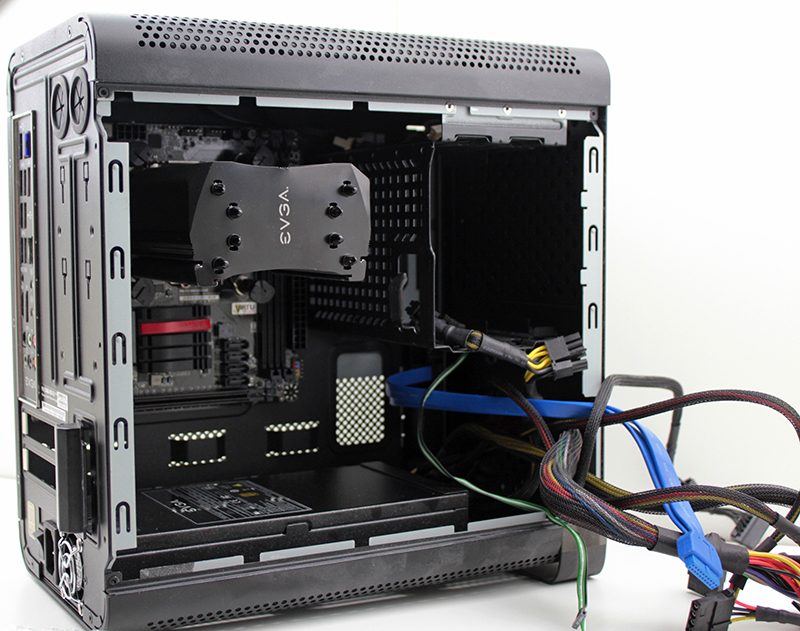
There are not many cable going out from the PSU but again it would be nice to see modular design here, at least for PCIe and Molex cables. The standard 20+4-pin and 8-pin ATX/CPU power connectors are provided, one dual-head 6+2-pin PCIe power connector, two SATA connectors on one cable and four Molex connectors on two separate cables. We think it would be better to have four SATA connectors instead.
Hadron Air is mini-ITX PC case but unless you want to use a dual-GPU configuration or you need motherboard with several expansion slots, mini-ITX motherboards are a good base for building powerful gaming PC. There are great mini-ITX motherboards based on the latest Z170 chipset, for example EVGA Z170 Stinger (you can use any CPU and memory compatible with standard Z170 motherboards). For this review we used an older EVGA Z87 Stinger motherboard.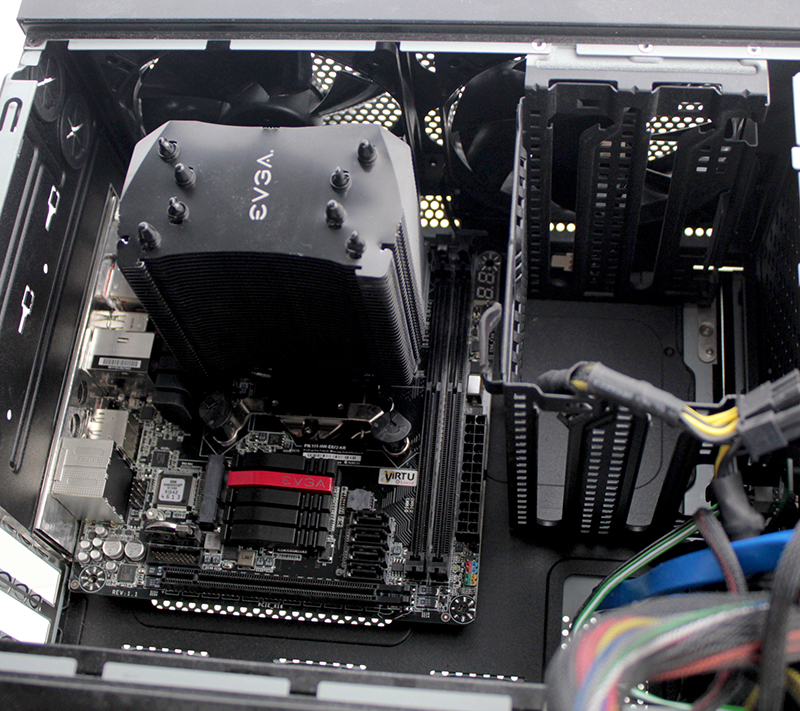
Many CPU coolers are available but you can use only those with total height up to 140mm. We used two coolers for the testing. The first one is EVGA mITX cooler which makes installation of other components easier since it uses push-in pins and it can be mounted after everything else is placed inside the chassis (image below left). The second cooler is Noctua NH-L12, L-type low profile cooler. Noctua cooler uses a retention mechanism that must be placed under the motherboard, so the cooler must be mounted on the motherboard outside of the chassis (image below right). 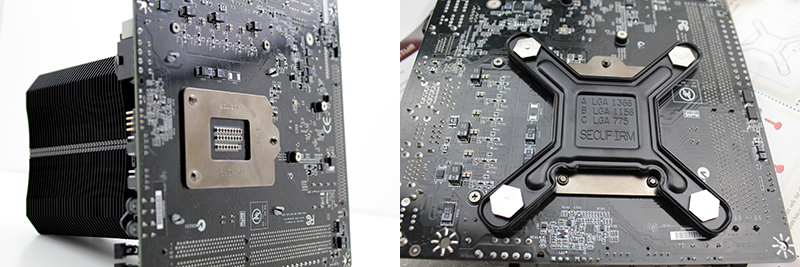
The Noctua cooler will hide the memory slots on the motherboard (image below), and you will be forced to remove the motherboard just because you want to change a memory module. We like the Noctua NH-L12 more because it is quieter compared to EVGA mITX cooler. We are using EVGA cooler to make our life easier when changing components. Both coolers can cool an Intel Core i7-4770K.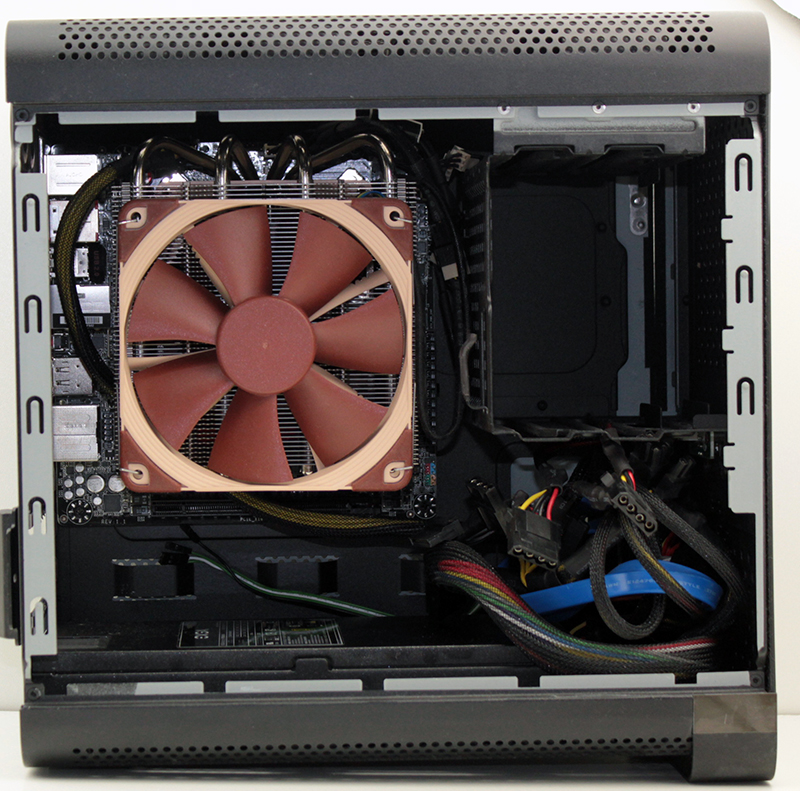
The Graphics card is secured outside of the chassis using standard screws. The anchor is extruded to keep the chassis as compact as possible. When using long graphics cards we found the easiest way was to the start installation by holding the card slantwise and put the I/O panel of the card through the opening at the back panel. Then it was a matter of twisting it once the front is already in the chassis. It is really a tight fit as you can see from the image below.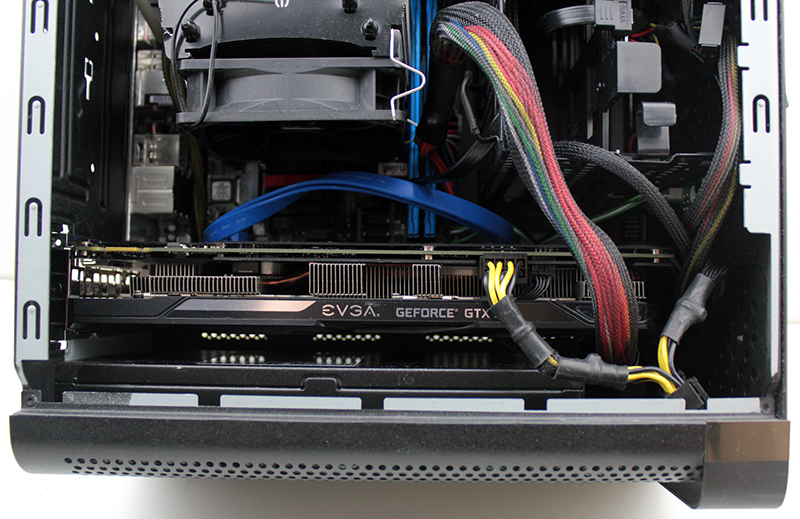
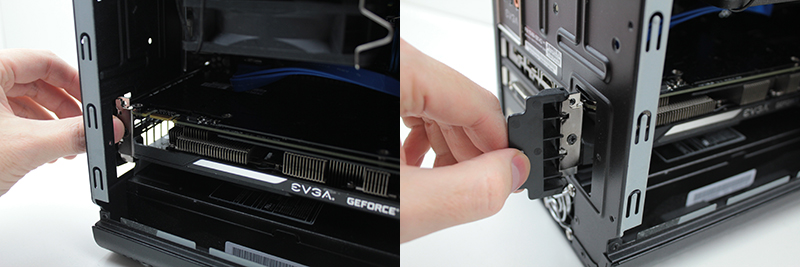
The GTX 960 SSC is close to the PSU, yet there is enough space for the graphics card cooler with two fans to get fresh air. The fans of the GPU cooler were not spinning most of the time during 2D work, thanks to the new feature found on the last gen graphics cards which stops a fan when the GPU is not hot.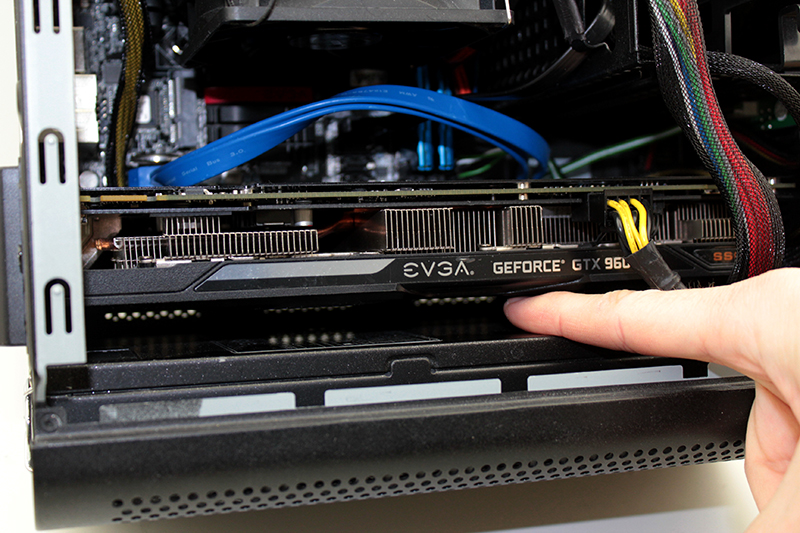
You can fit even a triple-slot graphics card, like we did using KFA2 GTX 780 Ti Hoff card, but we advice you against this since not enough place for good airflow. You can read more about our unusual setup here.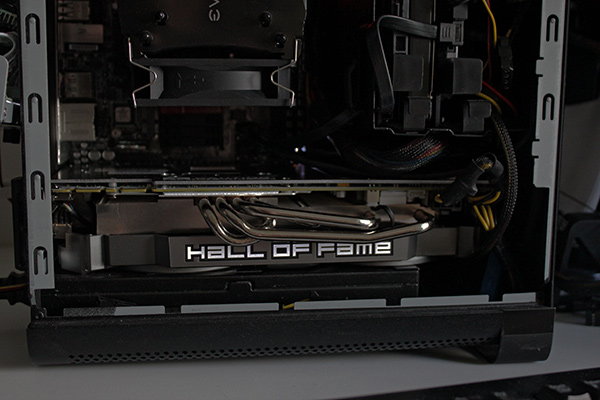
There are no dust filters in the Hadron Air but we think those are quiet important to have. As you can see from the image below, after we removed the pack panel, some months after the system was installed, we found a nice looking grid-like pattern of dust particles over the motherboard tray.

We like this design, but we don’t like the fact that the front stand is not covered in a layer of rubber. Be careful when mowing the Hadron Air over you working surface, you can scratch it or it will leave the black path like on the image below (luckily we were able to clean it). The chassis rests on a rubber pad at the back which makes it stable on the table.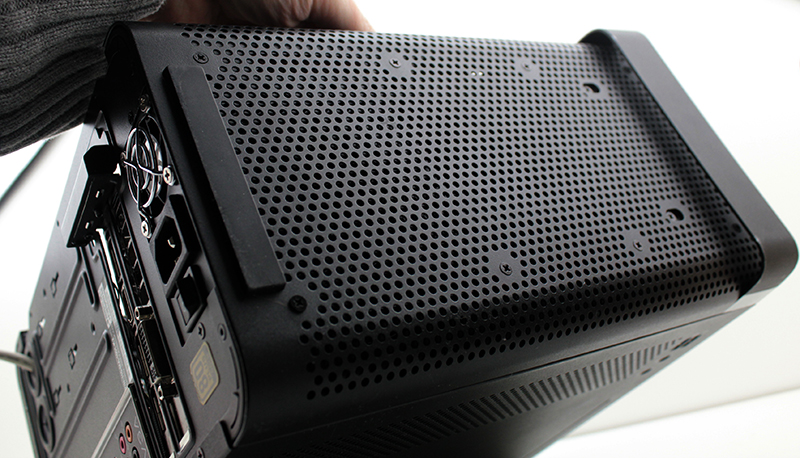
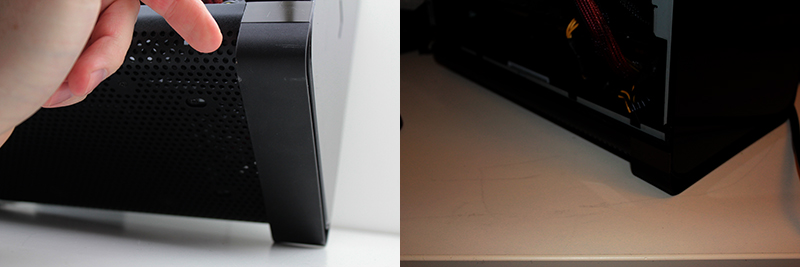
Conclusion
The Hadron Air is a good PC case for building a powerful system around a mini-ITX motherboard. Many users have it already and we see mostly great recommendations. Despite being already two years old, the Hadron Air has everything you will find on the latest designs, including USB 3.0 and HDD cage for 2.5” drives.
Mini-ITX motherboards are very powerful these days and feature rich too, like the latest Z710 motherboard which you can combine with the high-end Intel Core i7 CPU.
The Hadron Air can house dual slot graphics cards with lengths up to 267mm, including GTX Titan X. To power such powerful components you will need a good PSU. EVGA decided to ship a pre-installed 500 watt Gold rated PSU which of course adds to the price but we think it is a quality PSU, and fits well in the design. It is much quieter compared to most slim-line power supplies for mini-ITX chassis. The Hadron Air is equipped with two 120mm fans which are fairly silent.
EVGA Hadron Air is currently available for less than 160 euro, that is about 40 euro less compared to the original price. The price in Europe is considerably higher than in USA. The Image below shows the price graph for the Hadron Air which is quite unusual for a PC case, with huge difference between low and high values, but again. EVGA did a several promotions throughout the year 2014, which made considerable impact on the prices, as shown in the graph.
The EVGA Hadron Air makes an excellent first impression, and we are happy to say that after many months of using it we still have good opinion about it.